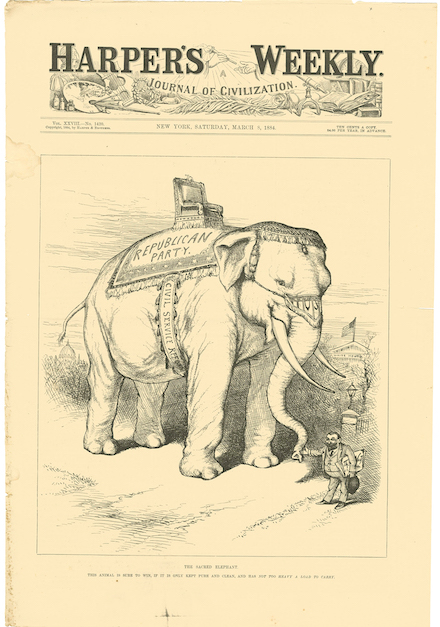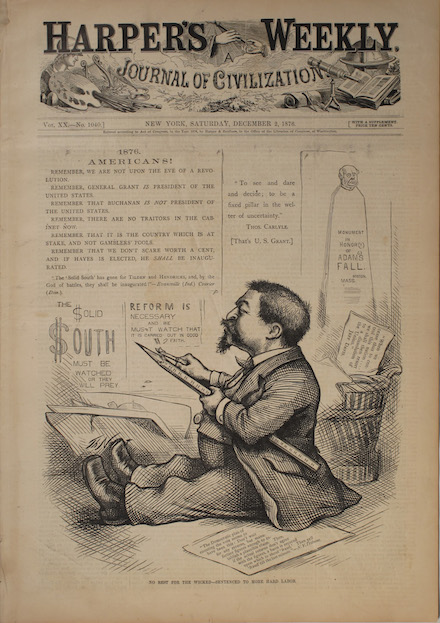
Thomas Nast (1840-1902), cover illustration for Harper’s Weekly, March 8, 1884. Norman Rockwell Museum Collections.
(STOCKBRIDGE, Mass.) – In “Presidents, Politics, and the Pen: The Influential Art of Thomas Nast,” opening Saturday, September 10, with a program at 5:30, Norman Rockwell Museum takes a look back at the 19th century to examine the impact that one of the nation’s greatest image-makers had over its politics. The exhibition will remain on view through Sunday, December 4.
Award-winning political cartoonist and historian Steven Brodner will provide a lively look at Nast’s career, as part of the opening festivities on Saturday, September 10, at 6:30pm. Admission to the event is $20, or free for museum members. The show’s curators will offer special gallery tours of the exhibition on Wednesdays, September 14, October 26, and November 16, at 3pm.
Thomas Nast (1840-1902) was a noted illustrator whose political cartoons had considerable influence over the nation 150 years ago. Known as “The President Maker,” Nast’s cartoons proved crucial in affecting the outcome of six presidential elections, which his favored candidates were known to win. The artist held presidential hopefuls accountable for the issues of the day — from political corruption to imperialism, inflation, and civil rights.
Although lacking formal education, Nast’s imagery included identifiable caricatures, scathing satire, and creative references to Shakespearean tales and Greek mythology. Nast’s representation of the donkey and elephant as symbols for the Democratic and Republican parties, respectively, continues to endure more than a century later.
“Presidents, Politics, and the Pen” will feature over 25 editorial cartoons by the “Father of the American Cartoon,” published by Harper’s Weekly between 1864 and 1884. The exhibition will include original artworks on loan from Macculloch Hall Historical Museum, a digital tour, as well as original Harper’s Weekly tearsheets donated to the museum by Stephen Yasinow and Laurie Cormier. The display will reflect the artist’s pointed opinions on the presidential candidates and campaigns of the day.
“Thomas Nast’s work was very effective in showcasing his sense of humor and strong opinions,” notes Norman Rockwell Museum archivist Venus Van Ness, who organized the exhibition along with fellow curator Barbara Rundback. “Not only did his work influence generations of artists, but the topics he commented on remain timely and at the forefront of politics to this day.”
Contemporary illustrator/political cartoonist Steve Brodner adds that, “Thomas Nast was the most important political cartoonist in the United States. He was given extraordinary gifts: super human skill; a perfect political storm to satirize; a very small media ecosystem, where every jolt hit like a hurricane; and a reproduction method that enabled all his work to look like it was the work of many men. There will never be another Nast, but none of us working cartoonists will ever get that through our heads. We try every day to hit the bulls-eye as well as he did.”
More About Thomas Nast
Born in Landau, Germany in 1840, Thomas Nast immigrated to the United States with his family at age six. Nast demonstrated artistic talent early on, and joined the staff of Harper’s Weekly magazine in 1862, at the age of 22. First published on January 3, 1857, Harper’s Weekly was aimed at the middle and upper socio-economic classes; when the Civil War commenced, Harper’s supported President Abraham Lincoln, the preservation of the Union, and the Republican Party. Military coverage was at the forefront of every issue, that kept soldiers at the fronts and their families at home informed on latest skirmishes.
Acting as a reporting illustrator for Harper’s, Nast depicted the Civil War battlefield and camp scenes by drawing emotionally charged pictures of adventure and bravery as well as its bloody tragedy. Published September 3, 1864, one of his most popular illustrations, Compromise with the South, depicts Columbia – a classically draped female figure symbolizing America – weeping over the grave of Union soldier while a surviving soldier shakes the hand of Jefferson Davis. This image was later used by Republicans in the 1864 campaign to re-elect Lincoln, and helped launch Nast’s career as a prominent artist and celebrity illustrator.
Nast continued working for Harper’s for 24 years, leaving in 1886. Having lost most of his fortune due to bad investments, he returned to the lecture circuit and took other cartooning commissions. He also took control of a failing magazine, the New York Gazette, and renamed it Nast’s Weekly.
In 1902, President Theodore Roosevelt, an admirer of the artist, offered Nast an appointment as the United States’ Consul General to Ecuador. Just five months into working in his new position, Nast contracted yellow fever and died on December 7, 1902. He was buried in Woodlawn Cemetery in The Bronx, New York City, yet his influence can be felt in political cartoons to this day.
Norman Rockwell Museum is located on 36 park-like acres in Stockbridge, Massachusetts, Rockwell’s hometown for the last 25 years of his life. The Museum is open year-round; closed Thanksgiving, Christmas, and New Year’s Day. From May through October, hours are 10 a.m. to 5 p.m. daily; from November through April, hours are 10 a.m. to 4 p.m. Monday through Friday, and 10 a.m. to 5 p.m. on weekends and holidays. The museum will be open 10 a.m. to 7 p.m. on Thursdays during the month of August. Rockwell’s studio is open May through October, 10 a.m. to 5 p.m. Museum admission is $18, $17 for seniors, $16 for military veterans, $10 for students, $6 for kids and teens 6 to 18, and free for museum members and children 5 and under.

